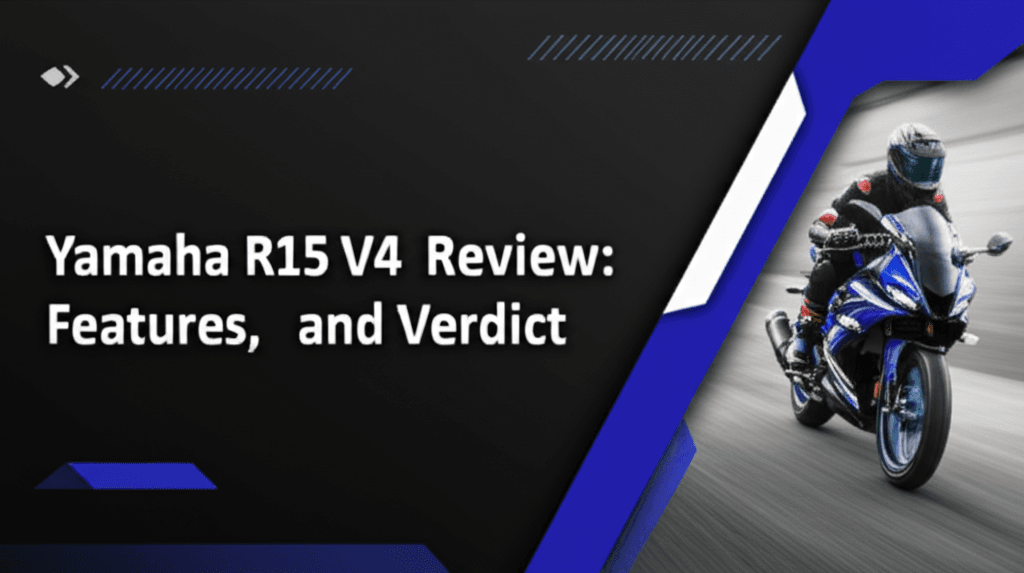Introduction
The Yamaha R15 V4 has rapidly become a benchmark in the entry-level supersport segment, blending premium styling, track-inspired dynamics, and real-world usability. Positioned as a gateway to Yamaha’s R-series DNA, the R15 V4 offers a compelling mix of performance, technology, and efficiency that appeals to daily commuters and weekend enthusiasts alike. With its sharp fairing, revised ergonomics, and a suite of electronic aids uncommon in its class, the R15 V4 is more than a cosmetic update—it’s a meaningful evolution.
In this comprehensive review, we dive deep into its engine performance, ride and handling, features and technology, ergonomics, fuel efficiency, and value proposition. Whether you’re a first-time sportbike buyer, upgrading from a commuter, or an enthusiast seeking a capable track-day tool on a budget, this guide will help you decide if the Yamaha R15 V4 deserves a spot in your garage.
Design, Styling, and Build Quality
Yamaha has leveraged its R-series lineage to give the R15 V4 a distinctive identity. The bike’s design borrows heavily from the R7 and R6, resulting in a sculpted fairing, a central bi-functional LED projector headlamp, and sleek LED position lamps. It looks every bit the mini superbike—purposeful, lean, and athletic.
R-series DNA and Aerodynamics
The fairing isn’t just for show. Yamaha claims improved aerodynamics with a reduced drag coefficient, which aids high-speed stability and potentially improves fuel economy. The windscreen is slightly taller than earlier versions, helping deflect wind off the rider’s chest at highway speeds.
Fit and Finish
Panel gaps are tight, paint quality is glossy, and the switchgear feels reassuring. The seat stitching, tank plastics, and the neatly integrated tail section reflect Yamaha’s emphasis on durability. The overall finish puts it a notch higher than many rivals in its segment.
Practical Touches
- Dual-tone seat with adequate cushioning for short to medium rides
- Clip-on handlebars with adjustable angle (depending on variant), improving ergonomics
- Compact tail that complements the sporty stance and improves pillion space marginally over earlier models
Engine, Performance, and Rideability
At the heart of the Yamaha R15 V4 lies a 155 cc, single-cylinder, liquid-cooled engine with Variable Valve Actuation (VVA). This technology enhances top-end performance without sacrificing low-end tractability—a hallmark of the R15 series that continues to impress.
Engine Characteristics
The motor delivers a peppy mid-range and a strong top-end for its displacement. The VVA system uses two different cam profiles—one for low to mid rpm and the other for high rpm—engaging around the mid-range to keep the power flowing seamlessly. It’s a willing revver, inviting you to chase the redline while maintaining respectable city manners.
Performance Metrics and Real-World Feel
- 0-60 km/h in roughly 4 seconds (rider/conditions dependent)
- Top speed sits around 135-140 km/h, achievable on a long, flat stretch
- Best enjoyed between 7,000-10,000 rpm, where the engine feels most alive
In urban traffic, the R15 V4 remains manageable thanks to its smooth fueling and predictable throttle response. Out on the highway, it holds 80-100 km/h effortlessly, with the gearing tuned for usable mid-range overtakes.
Transmission and Assist Features
Yamaha offers a slick 6-speed gearbox paired with an assist and slipper clutch. The assist mechanism lightens the clutch pull—useful in stop-go traffic—while the slipper function prevents rear-wheel hop during aggressive downshifts. On higher trims, a quickshifter (upshift) adds convenience, delivering clutchless upshifts at higher rpms for a more track-oriented experience.
Chassis, Handling, and Braking
Handling excellence is the Yamaha R15’s calling card, and the V4 iteration elevates it further. The bike’s rigid Deltabox frame provides a stable platform, while the suspension setup balances everyday comfort with sportiness.
Suspension Setup
The R15 V4 features a telescopic/upsidedown front fork (USD, on many variants) and a linked rear monoshock. The USD fork significantly improves front-end feedback, making corner entry more confident and precise. The rear is tuned to keep the bike planted during quick transitions.
Braking Performance
- Front: Disc with dual-piston caliper
- Rear: Disc with single-piston caliper
- ABS: Dual-channel on higher variants, single-channel on some market trims
Brake feel is progressive with adequate bite. Dual-channel ABS adds safety when braking hard on imperfect surfaces. For spirited riding, the setup delivers strong stopping power without excessive dive.
Tyres and Grip
Depending on the market and variant, the R15 V4 typically ships with 100/80 front and 140/70 rear tyres. These offer a good balance of grip and longevity. Enthusiasts looking for sharper grip might consider premium rubber upgrades, especially if frequenting track days or spirited mountain runs.
Features, Technology, and Connectivity
Yamaha packs the R15 V4 with a suite of features that was once the domain of larger, more expensive bikes. The technology elevates both performance and convenience, making the V4 one of the most feature-complete options in its class.
Electronics Package
- Variable Valve Actuation (VVA) for broader power delivery
- Assist & Slipper Clutch to reduce fatigue and enhance corner entry stability
- Traction Control System (TCS) on select variants for added safety on slippery surfaces
- Quickshifter (up) on specific trims for clutchless upshifts
- Dual-channel ABS for improved braking confidence
Instrumentation and Connectivity
The fully digital LCD cluster offers two display modes—Street and Track—changing the layout to prioritize different information. Through Yamaha’s Bluetooth connectivity (Y-Connect in some regions), riders can access call/SMS alerts, maintenance recommendations, last parked location, and ride analytics. While not essential, these features enhance the ownership experience, especially for tech-savvy riders.
Lighting and Visibility
The LED projector headlamp improves nighttime visibility and gives the bike a premium look. The beam spread and intensity are well-tuned for urban and highway riding, though enthusiasts may prefer auxiliary solutions for extended night rides on unlit roads.
Ergonomics, Comfort, and Practicality
Despite its supersport silhouette, the R15 V4 retains reasonable day-to-day usability. The ergonomics are sporty but not extreme, allowing for longer commutes or weekend rides without excessive fatigue.
Riding Triangle
- Seat height around 815 mm, workable for riders around 5’6” and above
- Clip-ons set lower than a standard street bike but higher than track-only machines
- Rear-set footpegs encourage a tucked-in posture at speed
The net effect is a mildly aggressive position that suits spirited riding while remaining manageable for city duties. Taller riders may find the knee bend snug; shorter riders might need practice to maneuver at parking speeds.
Seat and Pillion Comfort
The rider seat is supportive for 60-90 minutes at a stretch. The pillion perch, while more usable than some earlier R15 generations, remains compact—adequate for short trips. If two-up riding is a priority, consider aftermarket seat foam upgrades.
Everyday Usability
- Ground clearance is adequate for most speed breakers
- Turning radius is city-friendly
- Heat management is generally good; the liquid-cooling and fairing ducts minimize engine heat at low speeds
Fuel Efficiency, Ownership Costs, and Value
One of the R15 V4’s greatest strengths is its ability to deliver premium-bike feel without premium running costs. For many buyers, the combination of fuel efficiency, reliability, and resale value seals the deal.
Fuel Efficiency
- City: Approximately 40-45 km/l with gentle riding
- Highway: 45-50+ km/l at steady speeds
Riding style, traffic, and maintenance practices significantly influence these numbers. The engine’s efficiency and aerodynamic bodywork help stretch every liter of fuel.
Maintenance and Reliability
Scheduled service intervals are well-spaced, and consumables like brake pads and chains are reasonably priced. Yamaha’s service network coverage is extensive in many markets, contributing to strong reliability perceptions. Regular chain lubrication, tyre pressure checks, and oil changes will keep the bike performing at its best.
Resale and Value Proposition
Thanks to its reputation, the R15 generally enjoys robust resale value. When you factor in the extensive features—VVA, ABS, optional quickshifter, TCS, and a premium chassis—the R15 V4’s price tag makes sense for riders seeking a versatile sport machine that does not compromise on excitement or social appeal.
Variants, Rivals, and Which One to Buy
The R15 V4 is available in multiple variants and color options, often including a premium “M” trim with additional electronics and finishes. Understanding where it sits among rivals helps clarify its strengths and trade-offs.
Common Variants
- Standard: Core package with ABS and VVA
- Higher trims (e.g., M): Add features like quickshifter, TCS, and special liveries
Key Rivals
- KTM RC 125/200: Sharper track focus, stronger performance in the 200, but typically lower fuel efficiency
- Suzuki Gixxer SF 250: Bigger engine and effortless highway cruising; heavier and less feature-rich on electronics
- Honda CBR150R (market-dependent): Smooth and refined; fewer features in some regions
- TVS Apache RR 310 (higher segment): More power and features; higher price and running costs
Which One to Buy
If you prioritize handling finesse, fuel economy, and electronics without jumping into higher displacement costs, the R15 V4—especially the M variant—is a sweet spot. If you want a more relaxed touring demeanor with stronger mid-range torque, a 200-250 cc rival might suit you better.
Practical Examples and Real-World Scenarios
Beyond specs, here’s how the R15 V4 fits into everyday and enthusiast use cases.
Daily Commuting
- Pros: Light clutch action, nimble handling, excellent fuel economy
- Cons: Leaning posture can tire wrists over very long congestion-heavy days
- Tip: Keep tyre pressures spot-on and chain clean to maintain smoothness and mileage
Weekend Rides
- Pros: Engaging top-end, stable chassis, wind protection
- Cons: Pillion comfort limited; seat can feel firm after 2+ hours
- Tip: Add a tank bag and a gel seat insert for longer scenic rides
Track Days
- Pros: Predictable handling, usable electronics, quickshifter (on equipped trims)
- Cons: Power ceiling constrained by 155 cc class
- Tip: Upgrade to stickier tyres and set correct suspension sag for your weight
Beginner-Friendly Learning Platform
- Pros: Forgiving power delivery, safety aids like ABS and TCS, stable chassis
- Cons: Seat height can be intimidating for shorter riders
- Tip: Practice slow-speed maneuvers in a safe area to build confidence
Feature Comparison Table
| Feature | Yamaha R15 V4 | KTM RC 200 | Suzuki Gixxer SF 250 |
|---|---|---|---|
| Engine | 155 cc, liquid-cooled, VVA | 199.5 cc, liquid-cooled | 249 cc, oil-cooled |
| Power Delivery | Strong top-end, smooth mid-range | Stronger mid-top, more torque | Linear torque, relaxed cruising |
| Electronics | ABS, TCS (select), quickshifter (up), assist & slipper clutch | ABS, no TCS, no quickshifter (varies by market) | ABS, basic electronics |
| Fuel Efficiency | High (40-50+ km/l) | Moderate (30-35 km/l) | Moderate (35-40 km/l) |
| Ergonomics | Sporty but manageable | Aggressive, track-oriented | More relaxed |
| Best For | Balanced sport + daily use | Enthusiasts seeking performance | Touring and city comfort |
Actionable Buying and Ownership Tips
- Test Ride Both Variants: If available, try the standard and higher trims back-to-back. See if the quickshifter and TCS justify the price for your use.
- Set Your Ergonomics: Adjust lever reach, tyre pressure, and riding gear choice to reduce fatigue on longer rides.
- Break-In Properly: Follow manufacturer-recommended run-in. Avoid prolonged high rpm in the first 1,000 km for optimal engine longevity.
- Maintain the Chain: Clean and lube every 500-700 km or after rain rides. A well-maintained chain reduces noise and improves throttle response.
- Tyre Upgrades: If you intend to track the bike, consider higher-grip tyres within OEM sizes to preserve handling neutrality.
- Protective Accessories: Frame sliders, tank grips, and a radiator guard are practical additions to preserve aesthetics and function.
SEO Keywords and Phrases Integrated
Yamaha R15 V4 review Yamaha R15 V4 performance R15 V4 features and specifications R15 V4 mileage and

